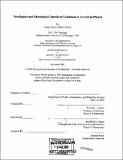Petrological and rheological controls on volcanism to terrestrial planets
Author(s)
Elkins Tanton, Linda Tarbox, 1965-
DownloadFull printable version (21.98Mb)
Other Contributors
Massachusetts Institute of Technology. Dept. of Earth, Atmospheric, and Planetary Sciences.
Advisor
Timothy L. Grove and Bradford H. Hager.
Terms of use
Metadata
Show full item recordAbstract
Through experimental petrology and geodynamic modeling, processes of melting under thick lithospheres on the Earth and the moon are investigated. Phase equilibrium experiments were carried out on Apollo 14B and 15C picritic glasses (Chapters 5 and 6) and on a Sierran high-potassium lava (Chapter 1). These, along with petrologic modeling of Cascades high alumina olivine tholeiites (Chapter 4), yield information on depths and pressures of melt generation and constraints on source composition. Geodynamic modeling of lithospheric thinning processes, including delamination under the Siberian flood basalts (Chapter 2), gravitational instabilities in the lunar magma ocean cumulates (Chapter 7), and thinning and convection due to giant meteorite impacts (Chapters 3 and 8), has lead to new models for melt production. These studies together show how lithospheric thinning and unusual mantle compositions can lead to melting without calling on unusual mantle potential temperatures, and can explain the volumes and durations of continental flood basalts and lunar mare basalts.
Description
Thesis (Ph. D.)--Massachusetts Institute of Technology, Dept. of Earth, Atmospheric, and Planetary Sciences, 2002. Includes bibliographical references.
Date issued
2002Department
Massachusetts Institute of Technology. Department of Earth, Atmospheric, and Planetary SciencesPublisher
Massachusetts Institute of Technology
Keywords
Earth, Atmospheric, and Planetary Sciences.